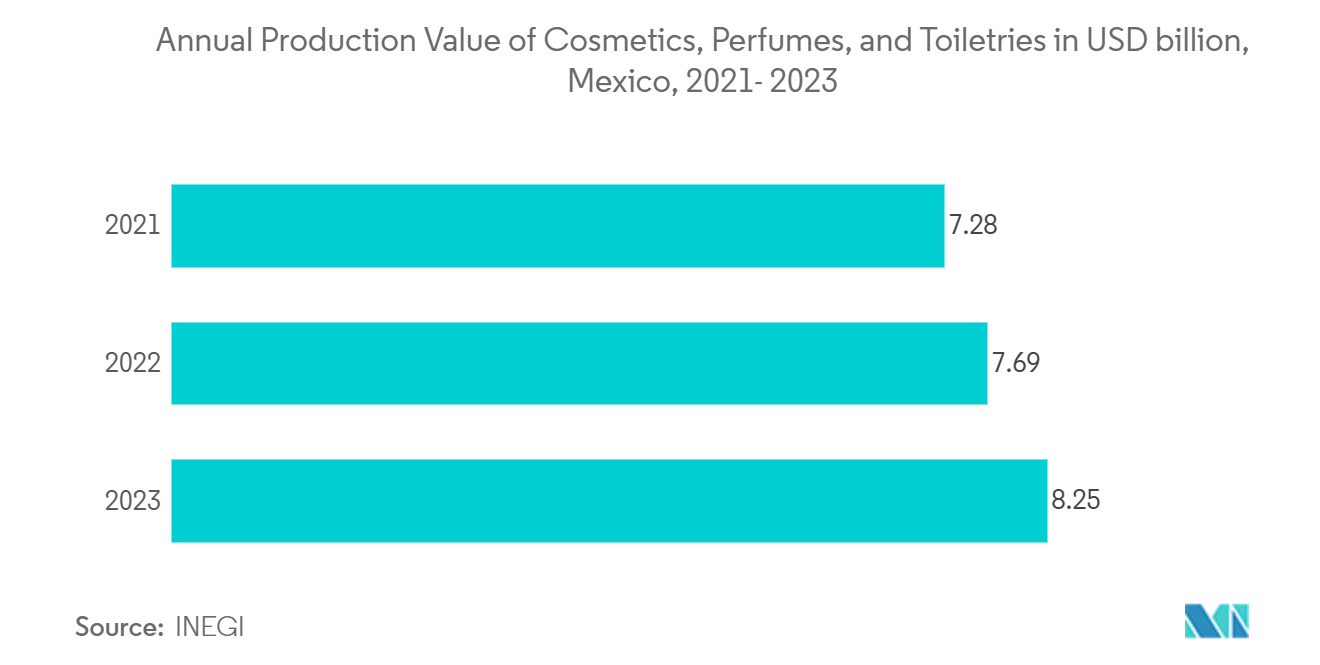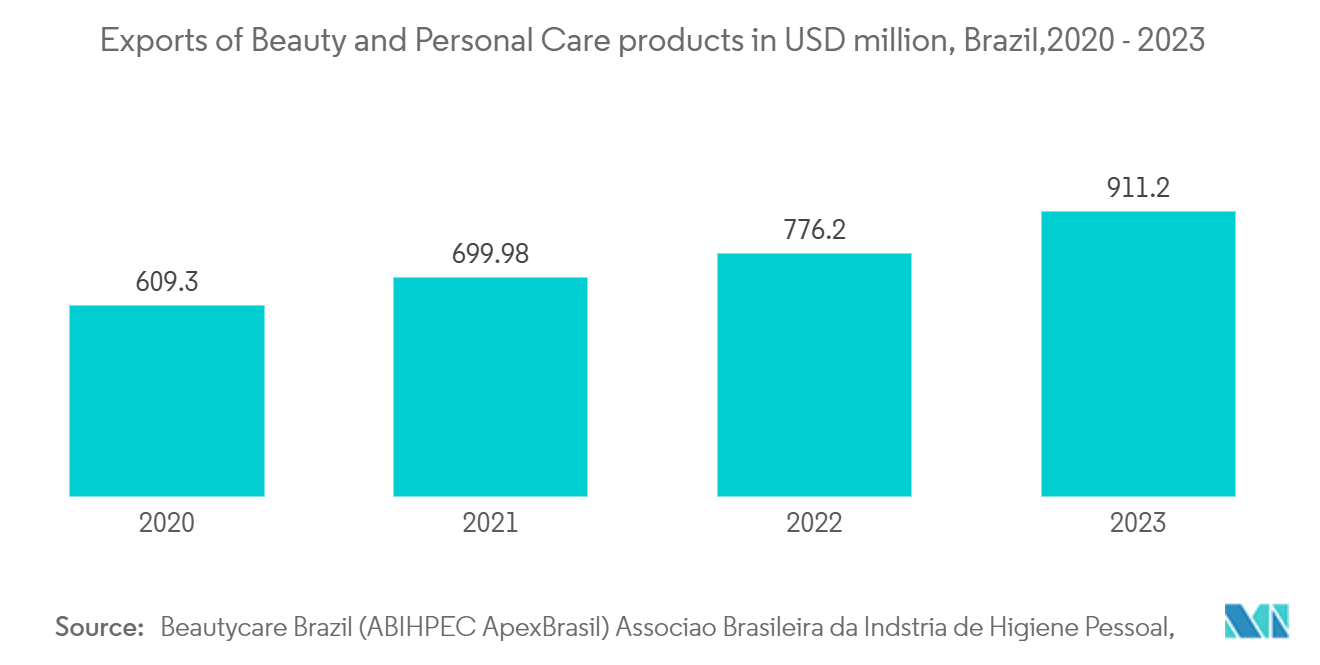Market Trends of Latin America Cosmetic Packaging Industry
Glass Bottles and Containers to Hold Significant Market Share
- Glass packaging has gained popularity for storing liquid medicines, cosmetics, and perfumes across various industries. These containers are crafted from high-quality glass and feature a plastic dropper, distinguishing them from traditional medicine bottles. The dropper enables precise dispensing of liquids and minimizes waste. Using glass for these containers offers several advantages, including chemical inertness, transparency, and recyclability.
- Glass bottles are widely used for storing liquid medicines, skincare products, perfumes, and other applications requiring accurate dosage control. The pharmaceutical industry, in particular, benefits from glass packaging because it maintains product integrity and extends shelf life. The cosmetics and personal care industries also utilize glass bottles for premium products, leveraging their aesthetic appeal and perceived quality. The versatility of glass packaging and the functionality of droppers has led to its adoption in various niche markets, such as essential oils and aromatherapy products.
- The market for glass bottles is expected to grow significantly during the forecast period, driven by the increasing demand for natural fragrances over synthetic-based ingredients and the rising popularity of luxury perfumes. This trend has prompted companies to invest in innovative designs for perfume glass bottles, exploring unique shapes, textures, and embellishments to enhance product appeal. Perfume glass bottles are considered high-end luxury items due to their well-rounded shapes and excellent reflectivity, which contribute to the overall sensory experience of the fragrance.
- The glass material also helps preserve the scent's integrity and extends its shelf life. In 2023, Mexico's production of cosmetics, perfumes, and toiletries reached over USD 8.25 billion, an increase from USD 7.69 billion in 2022. This growth reflects the increasing consumer demand for premium beauty and fragrance products and Mexico's strengthening position in the global cosmetics and perfume industry.
- Increasing consumer awareness of environmental impact has driven a growing demand for sustainable products that reduce waste. This trend has significantly boosted the popularity of refillable glass bottles in the perfume industry. Refillable perfume bottles align with eco-conscious values by eliminating the need for disposable packaging and substantially reducing plastic waste. Being infinitely recyclable without quality degradation, glass has emerged as the preferred material for refillable perfume containers.
- This shift toward refillable glass bottles addresses environmental concerns and offers consumers a more luxurious and long-lasting product experience. Perfume brands respond to this trend by introducing refill options for their popular fragrances, allowing customers to reuse their original bottles and reducing overall packaging waste. Additionally, using refillable glass bottles often results in cost savings for consumers in the long run, as refills are typically priced lower than purchasing a new bottle with the same amount of perfume.

Brazil to Register Significant Growth
- The expanding female population in Brazil significantly drives the demand for cosmetic products in the region. This demographic shift is expected to boost the makeup market across the country. The increasing number of women in the workforce and rising disposable incomes contribute to the growth of the cosmetics industry. Brazilian women are known for their beauty consciousness and willingness to invest in personal care products, further fueling market expansion.
- Additionally, Brazil presents a promising market for skin care product developments and launches, driven by consumer attitudes towards maintaining quality of life. The country's diverse climate and environmental conditions create unique skincare needs, prompting manufacturers to develop specialized products. Brazilian consumers are increasingly seeking multifunctional skincare solutions that address various concerns simultaneously, such as anti-aging, sun protection, and hydration.
- The demand for organic and vegan skin care products is also rising as veganism gains traction among young and older adults in Brazil. This trend is a broader shift towards more sustainable and ethically produced cosmetics. Consumers are becoming more aware of ingredient sourcing and environmental impact, leading to increased interest in natural, plant-based, and cruelty-free products. Local and international brands are responding to this demand by expanding their eco-friendly and vegan product lines, catering to the evolving preferences of Brazilian consumers.
- Brazil imports perfumes, cosmetics, and bath products from Argentina, Colombia, and Chile. The country also sources cosmetics from France and the United States. Brazil continues to rely on imports for the production of finished products. To encourage local production, the Brazilian government has implemented import taxes. Companies like Albea are focusing on localizing their cosmetic packaging operations in Brazil. In 2023, Brazil's exports of beauty and personal care products surpassed imports, resulting in a trade surplus. That year, Brazil exported cosmetics and hygiene products worth over USD 911 million to international markets, a significant increase from the previous year. Before 2020, Brazil recorded trade deficits in this market. Key product segments in the Brazilian beauty and personal care market include skin care products, sunscreen, bronzers, and hair care.
- Brazil, renowned for its high-quality and diverse hair products, is now expanding its presence in the skincare market. The country's cosmetics industry responds to changing consumer preferences by introducing a wider range of skincare products and sustainable packaging options. Brazilian skincare brands emphasize sustainability and digital innovation, developing products tailored to the diverse skin tones and unique beauty needs of the Brazilian population. These products leverage the country's rich biodiversity, incorporating natural ingredients sourced from its vast ecological resources.
- Brazil's franchising industry is among the world's largest and most advanced, with specific legislation governing the sector. The country ranks fifth globally in terms of franchise chain numbers. In the cosmetics market, the perfume segment shows consistent growth, driving demand for related products like dispensing systems and spray caps. Despite price sensitivity, Brazilian consumers are willing to invest in premium cosmetic products.


